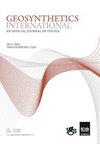粘性和粒状填土加筋挡土墙结构的数值分析
IF 2.8
2区 工程技术
Q2 ENGINEERING, GEOLOGICAL
引用次数: 100
摘要
采用有限元数值分析方法,对加筋土可伸缩节段墙的破坏机理进行了研究。数值方法首先与文献中报道的三个仪器全尺寸结构的结果进行了验证。分析了不同配筋间距、配筋长度和回填土组合下的有限元模型。采用一种特殊的抗剪强度参数折减技术——c折减法对破坏条件进行了模拟。-c减少分析的结果用于评估当前土工合成筋土墙设计程序中使用的假设。特别地,剪切应变被用来识别破坏面。结果表明,无论是颗粒状充填体还是黏性充填体,随着系统接近破坏,潜在破坏面逐渐转向直接滑动模式。结果表明,在工作荷载作用下,现有设计分析中使用的潜在破坏面是正确的,但土工合成筋挡土墙在破坏时的破坏面接近于直接滑动型或双线性面,从墙脚开始,坡度很浅。本文章由计算机程序翻译,如有差异,请以英文原文为准。
Numerical analysis of reinforced soil-retaining wall structures with cohesive and granular backfills
The failure mechanisms of reinforced soil segmental walls with extensible reinforcements were studied by performing a numerical analysis using the finite element method. The numerical approach was first verified against the results of three instrumented full-scale structures reported in the literature. Finite element models with different combinations of reinforcement spacing, reinforcement length and backfill soil were analysed. The � -c reduction method, which is a special shear strength parameter reduction technique, was applied to simulate the failure conditions. The results of � -c reduction analysis were used to evaluate assumptions used in current design procedures for geosynthetic-reinforced soil walls. In particular, shear strains were used to identify failure surfaces. Interpretation of the results indicated that, for both granular and cohesive backfills, the potential failure surface gradually shifts to a direct sliding mode as the system approaches failure. As a result, under working loads the potential failure surface used in current design analysis is correct, but the failure plane of a geosynthetic-reinforced soil-retaining wall at failure approaches a direct sliding type or a bilinear plane, which starts from the toe of the wall with a very shallow slope.
求助全文
通过发布文献求助,成功后即可免费获取论文全文。
去求助
来源期刊

Geosynthetics International
ENGINEERING, GEOLOGICAL-GEOSCIENCES, MULTIDISCIPLINARY
CiteScore
6.90
自引率
20.00%
发文量
91
审稿时长
>12 weeks
期刊介绍:
An online only, rapid publication journal, Geosynthetics International – an official journal of the International Geosynthetics Society (IGS) – publishes the best information on current geosynthetics technology in research, design innovation, new materials and construction practice.
Topics covered
The whole of geosynthetic materials (including natural fibre products) such as research, behaviour, performance analysis, testing, design, construction methods, case histories and field experience. Geosynthetics International is received by all members of the IGS as part of their membership, and is published in e-only format six times a year.
 求助内容:
求助内容: 应助结果提醒方式:
应助结果提醒方式:


